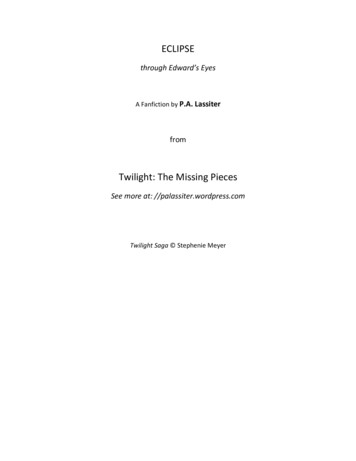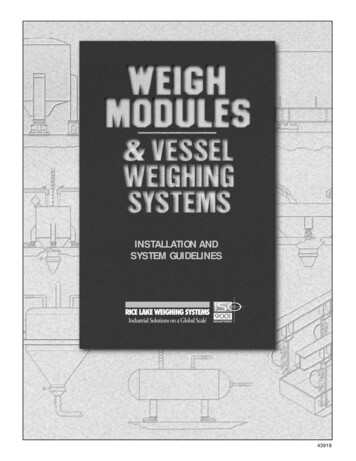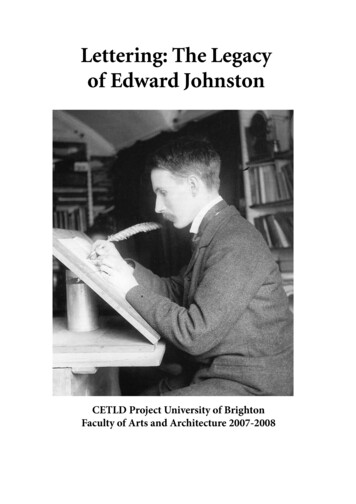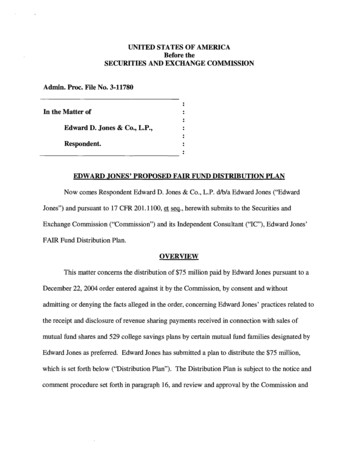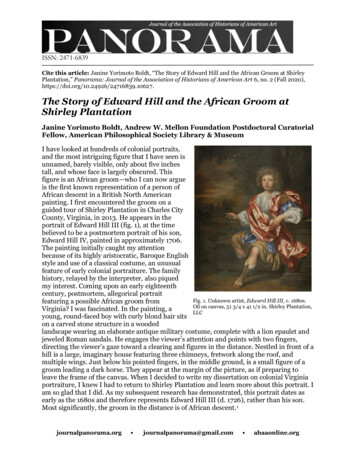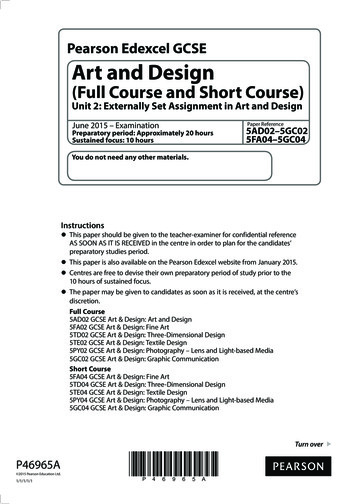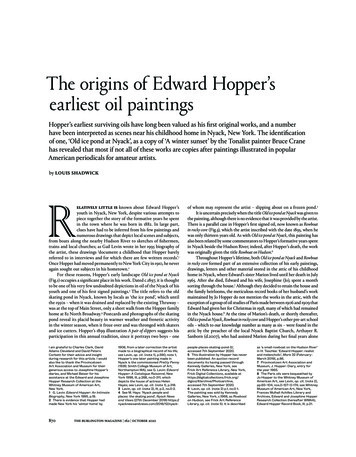
Transcription
The origins of Edward Hopper’searliest oil paintingsHopper’s earliest surviving oils have long been valued as his first original works, and a numberhave been interpreted as scenes near his childhood home in Nyack, New York. The identificationof one, ‘Old ice pond at Nyack’, as a copy of ‘A winter sunset’ by the Tonalist painter Bruce Cranehas revealed that most if not all of these works are copies after paintings illustrated in popularAmerican periodicals for amateur artists.by louis shadwickRelatively little is known about Edward Hopper’syouth in Nyack, New York, despite various attempts topiece together the story of the formative years he spentin the town where he was born in 1882. In large part,clues have had to be inferred from his few paintings andnumerous drawings that depict local scenes and subjects,from boats along the nearby Hudson River to sketches of fishermen,trains and local churches; as Gail Levin wrote in her 1995 biography ofthe artist, these drawings ‘document a childhood that Hopper barelyreferred to in interviews and for which there are few written records’.1Once Hopper had moved permanently to New York City in 1910, he neveragain sought out subjects in his hometown.2For these reasons, Hopper’s early landscape Old ice pond at Nyack(Fig.1) occupies a significant place in his work. Dated c.1897, it is thoughtto be one of his very few undoubted depictions in oil of the Nyack of hisyouth and one of his first signed paintings.3 The title refers to the oldskating pond in Nyack, known by locals as ‘the ice pond’, which untilthe 1950s – when it was drained and replaced by the existing Thruway –was at the top of Main Street, only a short walk from the Hopper familyhome at 82 North Broadway.4 Postcards and photographs of the skatingpond reveal its placid beauty in warmer weather and frenetic activityin the winter season, when it froze over and was thronged with skatersand ice cutters. Hopper’s 1899 illustration A pair of slippers suggests hisparticipation in this annual tradition, since it portrays two boys – oneI am grateful to Charles Clark, DavidAdams Cleveland and David PetersCorbett for their advice and insightduring research for this article. I wouldalso like to thank the ProvincetownArt Association and Museum for theirgenerous access to Josephine Hopper’sdiaries, and Michael Beiser for hisassistance at the Edward and JosephineHopper Research Collection at theWhitney Museum of American Art,New York.1 G. Levin: Edward Hopper: An IntimateBiography, New York 1995, p.18.2 There is evidence that Hopper hadmade New York his ‘winter home’ by870SHADWICK Hopper.indd 8701908, from a later correction the artistmade to a biographical record of his life;see Levin, op. cit. (note 1), p.590, note 1;Hopper’s one later painting made inNyack is the commissioned Pretty Penny(1939; Smith College Museum of Art,Northampton MA), see G. Levin: EdwardHopper: A Catalogue Raisonné, NewYork 1999, III, p.268, no.0-311, whichdepicts the house of actress HelenHayes; see Levin, op. cit. (note 1), p.318.3 Levin, op. cit. (note 2), III, p.2, no.0-2.4 See M. Hays: ‘Nyack people andplaces: the skating pond’, Nyack Newsand Views (27th December 2018) https://nyacknewsandviews.com/2018/12/nyack-of whom may represent the artist – slipping about on a frozen pond.5It is uncertain precisely when the title Old ice pond at Nyack was given tothe painting, although there is no evidence that it was provided by the artist.There is a parallel case in Hopper’s first signed oil, now known as Rowboatin rocky cove (Fig.3), which the artist inscribed with the date 1895, when hewas only thirteen years old. As with Old ice pond at Nyack, this painting hasalso been related by some commentators to Hopper’s formative years spentin Nyack beside the Hudson River; indeed, after Hopper’s death, the workwas originally given the title Rowboat on Hudson.6Throughout Hopper’s lifetime, both Old ice pond at Nyack and Rowboatin rocky cove formed part of an extensive collection of his early paintings,drawings, letters and other material stored in the attic of his childhoodhome in Nyack, where Edward’s sister Marion lived until her death in July1965. After she died, Edward and his wife, Josephine (Jo), spent a monthsorting through the house.7 Although they decided to retain the house andthe family heirlooms, the meticulous record books of her husband’s workmaintained by Jo Hopper do not mention the works in the attic, with theexception of a group of oil studies of Paris made between 1906 and 1909 thatEdward had given her for Christmas in 1958, many of which had remainedin the Nyack house.8 At the time of Marion’s death, or shortly thereafter,Old ice pond at Nyack, Rowboat in rocky cove and Hopper’s other pre-art schooloils – which to our knowledge number as many as six – were found in theattic by the preacher of the local Nyack Baptist Church, Arthayer R.Sanborn (d.2007), who had assisted Marion during her final years alonepeople-places-skating-pond-2/,accessed 7th September 2020.5 This illustration by Hopper has neverbeen published. An auction recorddocuments its having passed throughKennedy Galleries, New York, seeFrick Art Reference Library, New York,Frick Digital Collections, available chive/Photoarchive,accessed 7th September 2020.6 Levin, op. cit. (note 2) p.1, no.0-1.The painting was sold by KennedyGalleries, New York, c.1968, as Rowboaton Hudson, see Frick Art ReferenceLibrary, op. cit. (note 5). It is describedas ‘a small rowboat on the Hudson River’in H. Teschke: ‘Edward Hopper: realistand melancholic’, Mare 32 (February–March 2019), p.86.7 Provincetown Art Association andMuseum, J. Hopper: Diary, entry forthe year 1965.8 The Paris oils were bequeathed byJo Hopper to the Whitney Museum ofAmerican Art, see Levin, op. cit. (note 2),pp.65 104, nos.0-127 0-174; see WhitneyMuseum of American Art, New York,Frances Mulhall Achilles Library andArchives, Edward and Josephine HopperResearch Collection (hereafter WMAA),Edward Hopper Record Book, III, p.21.the burlington magazine 162 october 202017/09/2020 23:30
1. Old ice pond at Nyack, here identified as A winter sunset, after Bruce Crane, by Edward Hopper.Here dated 1898 1900. Oil on canvas, 29.8 by 50 cm. (Heather James Fine Art).2. A winter sunset, by Bruce Crane. 1880s. (Repr. The Art Interchange, 6th December 1890; photograph the author).the burlington magazine 162 october 2020SHADWICK Hopper.indd 87187117/09/2020 23:31
The origins of Edward Hopper’s earliest oil paintingsin the house. He became a friend of hers, and by extension of Edward andJo’s, driving them between New York and Nyack and later officiating atEdward’s funeral.9 Sanborn was eventually included in Jo’s will as one ofsix beneficiaries who were to divide between them the residue of her estatethat had not been bequeathed elsewhere.10 When Jo died on 6th March1968, only ten months after Edward, Sanborn continued to tend to thehouse in Nyack on behalf of her estate until 1970, when it was sold. Duringthis period he acquired the contents of the house, including Old ice pond atNyack, Rowboat in rocky cove and Hopper’s other earliest oils.Sanborn’s claim to the items in the Nyack house has been the subjectof dispute.11 For the purposes of this article, however, it is certain thatHopper’s earliest oils remained in the attic until some time between late1967 and June 1968, when Sanborn retrieved them, and that not longafterwards the works entered his collection.12 It is equally certain thatnone of them had been intended for the art market during the Hoppers’lifetimes. It is for this reason that the paintings had remained untitled and,with one exception, undated, and were never included in the record booksthat Jo Hopper produced to document her husband’s output.13Old ice pond at Nyack was first exhibited in 1980, when it was includedwith this title alongside two other early oils in a touring show of items fromSanborn’s collection, Edward Hopper: The Early Years, which travelled to overten galleries between 1980 and 1983.14 In 1982 Sanborn published an articleabout Hopper’s ancestry and boyhood in Nyack, in which he used thepainting and several other early works to document the artist’s connectionto the town.15 In Levin’s Edward Hopper: A Catalogue Raisonné (1999) it wasgiven the title [Old ice pond at Nyack], the brackets indicating that this titlewas a late addition.16 The painting then returned to its original home inNyack – now the Edward Hopper House Museum and Study Center –and was featured in two exhibitions, Prelude: The Nyack Years (2011) andEdward Hopper: Early Nautical Scenes (2012), for both of which the bracketswere dropped.17 Both exhibitions drew attention to thematic and stylisticparallels between Old ice pond at Nyack and Hopper’s mature oils.18 In 2019the painting was listed for sale by Heather James Fine Art, Jackson Hole,Wyoming, where it was exhibited alongside other items previously ownedby Sanborn, with the brackets once again omitted from the title.19 Rowboatin rocky cove, which was sold by Kennedy Galleries, New York, in the late1960s on behalf of Sanborn, has never been publicly exhibited.20It is clear that the title and date of Old ice pond at Nyack were providedby Sanborn, who made the visual link to the skating pond in Nyack andused the painting to evoke Hopper’s boyhood in exhibitions, articles andtalks. He evidently was also responsible for the original title of Rowboatin rocky cove, which was called Rowboat on Hudson when he consigned thework to Kennedy Galleries – again making a link to the Nyack scenery ofHopper’s youth.21In fact, neither Old ice pond at Nyack nor Rowboat in rocky cove bear anyrelation to Nyack since both, it can now be revealed, are copies of paintingsby other artists. Old ice pond at Nyack is a copy of A winter sunset (Fig.2) bythe Tonalist artist Bruce Crane (1857–1937), while Rowboat in rocky cove isa copy after a watercolour titled Lake view by an unknown painter (Fig.4).The first of these depicts a landscape in Long Island or Connecticut, andthe second is inscribed ‘Athelstane’ and so possibly depicts one of the lakesin the vicinity of Athelstane, Wisconsin.22 These discoveries open up freshlines of enquiry concerning Hopper’s youth and early development.Both of the works that Hopper copied were reproduced in theearly 1890s as collectable colour plates in a widely read periodical forart amateurs and students, the Art Interchange.23 A winter sunset appearedin December 1890 and the watercolour titled Lake view was printed inFebruary 1891. In both cases, the colour plates were accompanied bycomprehensive sets of instructions for art students for making copies.This probably explains the existence of several other contemporaneouscopies of A winter sunset.24 The instructions for copying were probablyprovided by Crane himself, since the text accompanying a reproduction ofanother of his works in a similar journal for art students, the Art Amateur,in March 1897, stated that ‘we asked Mr Bruce Crane, in giving directions9 On Sanborn, see Levin, op. cit.(note 1), p.577.10 WMAA, will of JosephineHopper, Box 4.4, Folder 4.040.11 This dispute is a result of JoHopper’s final bequest to the Whitney,which gave all of her and Edward’sremaining works of art to the museum,save for specific exceptions named inher will. See R. Pogrebin and K. Flynn:‘Hopper expert questions how ministergot an art trove’, New York Times, 20thNovember 2012, rce.html, accessed 3rdMarch 2020.12 A letter sent to Hopper’s galleriston behalf of the executor of Jo’s willmakes it clear that some items had beenremoved from the Nyack residence asearly as 23rd December 1967. SeeArchives of American Art, SmithsonianInstitute, Washington, Frank K.M. RehnGalleries records 1858–1969, Box 7, Reel5857 (hereafter AAA), letter fromLoring K. Manley to John Clancy, 8thMarch 1968. Sanborn’s son Philiprecalled that the oils were taken byhis father to Hopper’s gallerist, JohnClancy, for appraisal on the advice ofthe Bank of New York (the executor)and that shortly afterwards Sanbornpurchased the contents of the Nyackhouse. A letter of June 1968 sent toClancy on behalf of the executorconfirms that the gallerist was asked tomake ‘an appraisal of all the unsold artwork of Edward Hopper’. See PogrebinHopper: a favorite son’, New YorkTimes (10th June 2011), ard-hopper-videos.htmlm, accessed31st July 2020; and S. Gold: ‘Long before“Nighthawks”, a boy loved the Hudson’,New York Times (12th July 2012), https://nyti.ms/NrIrCi, accessed 31st July 2010.19 The exhibition, Edward Hopper,took place at Heather James Fine Art,Jackson Hole WY, 1st July–30thSeptember 2019. At the time of writing,the work is listed for auction on thegallery website, https://www.heatherjames.com/artistintro/?at EDWARDHOPPER, accessed3rd March 2020. The establishment of anew Sanborn–Hopper Family Archive atthe Whitney Museum of American Artwas announced in July 2017. Over 4,000previously unseen items such as letters,notebooks and photographs were givento the museum by the Arthayer R.Sanborn Collection Trust.20 The painting was purchased by ‘L.Rosenfeld’. Later it was purchased byRobert C. Atkins, who died in 2003,see Sale, Christies, New York, #5282:‘American Watercolors, Drawings,Paintings and Sculpture of the 19thand 20th Centuries’, 18th March 1983.See Levin, op. cit. (note 2), IV, CD-Rom.21 The work was later designated[Rowboat in rocky cove] in Levin,op. cit. (note 2), p.1, no.0–1, withthe title bracketed to show that itwas not Hopper’s.22 There is also an Athelstane Lake inOntario, Canada. ‘Athelstane’ could872SHADWICK Hopper.indd 872and Flynn, op. cit. (note 11); and AAA,letter from Loring K. Manley to JohnClancy, 6th June 1968.13 Jo used the record books to accountfor each work’s provenance, exhibitionhistory and other information. Sherecorded only works that were deemedsuitable for the art market; most ofHopper’s early drawings, illustrationsand art school works were not included,nor were his pre-art school oils.Hopper’s Paris oils – including twentysix unframed works in Nyack – are hisearliest works featured, save for fiveportraits Hopper made at art school,c.1903 04. See WMAA, Edward HopperRecord Book, I, pp.50 51; and EdwardHopper Record Book, II, pp.74 75.14 See P.C. Ritter: exh. cat. EdwardHopper: The Early Years: from theArthayer R. Sanborn Collection,Melbourne FL (Brevard Art Centerand Museum) 1980.15 A.R. Sanborn: ‘Edward Hopper:his Rockland heritage and his legacy’,South of the Mountains 26, no.3(July–September 1982), pp.2–816 Levin, op. cit. (note 2), III, p.2.17 See E.T. Colleary and A. Berman:Edward Hopper, Prelude: The NyackYears, Nyack NY (Edward HopperHouse Museum and Study Center) 2011.18 Parallels were drawn between OldIce Pond at Nyack and later Hopperworks such as Railroad sunset (1929;The Whitney Museum of American Art;Levin, op. cit. (note 2) p.194, no.0-268)by the curatorial team behind theseexhibitions. See S. Hodara: ‘Celebratingconceivably be a pseudonym for theartist. One possibility is the Britishcolonialist and amateur painter FrankAthelstane Swettenham (1850–1946),who produced many watercolours oflakes and water bodies in BritishMalaya throughout the 1880s. SeeL.C. Keat and H. Barlow: FrankSwettenham and George Giles:Watercolours and Sketches of Malaya1880–1894, Kuala Lumpur 1988.23 See J. Ferone: ‘Women and chinapainting at the turn of the twentiethcentury: an analysis of the influence of“The Art Amateur” and “The Art Interchange”’, unpublished PhD diss. (University of Akron, 2006), p.40, where it isstated that throughout the late nineteenth and early twentieth centuriesthe Art Interchange enjoyed ‘significantreadership throughout America’.24 Three other copies of Crane’s Awinter sunset have been identifiedduring the writing of this article. Twoare signed ‘Bruce Crane’. Charles Clarkeand David Adams Cleveland haveexpressed doubts about the authenticity of at least one of these works, citingthe existence of a number of fakeCranes that appeared on the market inhis day, which we might suppose werecopied from the reproductions, usingthe accompanying instructions, emailcorrespondence between the authorand Charles Clarke, 8th July 2020, andDavid Adams Cleveland, 7th July 2020.The unsigned copy was sold by SkinnerAuctioneers, Boston MA, on 14thNovember 2013, lot 1261.the burlington magazine 162 october 202018/09/2020 12:30
The origins of Edward Hopper’s earliest oil paintings3. Rowboat in rocky cove, here identified as Lake view, after an unknown artist, by Edward Hopper. 1895.Oil on canvas, 25.4 by 34.9 cm. (Private collection; photograph Frick Art Reference Library, New York).4. Lake view (‘Athelstane’). 1880s. (Repr. The Art Interchange, 14th February 1891; photograph the author).the burlington magazine 162 october 2020SHADWICK Hopper.indd 87387317/09/2020 23:35
The origins of Edward Hopper’s earliest oil paintingsfor the copying of his spirited sketch reproduced as a [colour] supplementthis month, to say something of what had specifically attracted him’.25His advice ranged from the type of canvas the artist should use to tips ondrawing, paint application, colour mixes and drying methods.26 Cranewas nearing the height of his popularity when the reproduction waspublished, and at least twelve further colour reproductions of his workappeared in art journals for students between 1880 and 1900, attesting tohis reputation and visibility during Hopper’s youth.27The precise date of Crane’s A winter sunset is uncertain, but the artistlikely painted it during the early 1880s, following his return from Europeto New York in 1881. An 1885 article in the journal Art Age referred tothe ‘broad stretches of snowy landscape’ in Long Island and Connecticutthat Crane was known to paint regularly.28 Several of Crane’s many otherwinter landscapes date from this time and it was a subject he returnedto in the late 1880s and beyond. A founding member of the Society ofAmerican Artists, an art teacher and a member and eventual president ofthe Salmagundi Club, Crane was well-known and respected within New5. Ships, here identified as A marine, after Edward Moran,by Edward Hopper. c.1898. Oil on canvas, 30.5 by 50.8 cm.(Foosaner Art Museum, Melbourne FL).6. A marine, by Edward Moran. 1880. (Repr. The Art Interchange,14th August 1886).7. Church and landscape, by Edward Hopper. c.1897. Oil on canvas,25.4 by 35.5 cm. (Heather James Fine Art).8. Church and landscape. Nineteenth century. Painted porcelain,27 by 34 cm. (Private collection; photograph Bellmans Auctioneers).874SHADWICK Hopper.indd 874York’s art circles as a leading representative of the Tonalist generationthat dominated American painting during the late nineteenth century.29His work remained popular throughout the 1890s and early 1900s andregularly appeared in New York exhibitions and auctions alongside thatof other prominent Tonalist painters such as George Inness and Crane’sformer teacher Alexander Wyant. According to an anonymous profile ofCrane published in the Art Amateur in 1894, his work was ‘in great demand’,and an unnamed reviewer for Brush and Pencil declared in 1899 that ‘BruceCrane is so well-known, and his exhibition is so much like other things ofhis, that it would be repetition to say much’.30The fact that the two plates that Hopper copied were publishedwithin months of one another strongly suggests that his family boughtor subscribed to the Art Interchange during the early 1890s. The magazineregularly advertised its subscription rates, and in 1890, for example, itoffered annual subscribers a collection of twenty-six of the colour plates,which would have included both the reproductions that Hopper copied.31In her biography Levin writes that Hopper was given books or magazinesof drawing instruction by his parents to study and we can now positthat such materials were available to him from as early as 1890, whenhe was eight years old.32 Hopper’s parents could also have purchasedreproductions from illustrated catalogues of the Art Interchange’spublished colour plates, but these individual reproductions lacked thewritten instructions included in the magazine and not all previouslypublished colour plates were made available through these catalogues.33Another reproduction that Hopper copied suggests that the Hoppersmay have subscribed to the Art Interchange from as early as 1886, whenthe burlington magazine 162 october 202018/09/2020 12:32
The origins of Edward Hopper’s earliest oil paintingsEdward was only four years old. Hopper’s early oil Ships (Fig.5), paintedc.1898, can be revealed to be a copy after A marine (Fig.6) by the well-knownAmerican painter Edward Moran (1829–1901).34 This painting had appearedas a colour reproduction in the Art Interchange in August 1886, again withcopying instructions. If the Hopper family had already subscribed to theArt Interchange by then, this was probably not solely for the benefit of youngEdward; the entire family was steeped in art and culture and Hopper’smother, Elizabeth, in particular encouraged both Edward and Marion tobe creative from a very early age.35 An amateur artist herself, Elizabethwould likely have approved of the Art Interchange, which was advertisedas the ‘most progressive art and household monthly magazine’.36 Enjoyinga middle-class, home-owning and predominantly female readership, theArt Interchange is now acknowledged to have played an important rolein the democratisation and feminisation of art in America during thelate nineteenth century. In addition to being one of the few Americanart magazines that printed good-quality illustrations and colour plates,it would have appealed to Elizabeth through its atypical focus on thedecorative and domestic arts.37Hopper would, of course, have been too young to have painted his oilswhen the prints he copied were first published, explaining why several yearspassed before he produced his 1895 oil Rowboat in rocky cove. Presumably itwas only when he had the confidence to work in this medium that heturned to the reproductions, which must therefore have been retained byhis family. Tellingly, the instructions that the Art Interchange provided forartists to accompany Lake view stated that the painting was ‘a very simplesubject and well adapted to beginners’.38 There is little mystery, then,as to why Hopper copied it for his first attempt at oil painting; indeed,his beginnings as a painter seem to have been more tentative than haspreviously been imagined.In all three paintings, the artist made no acknowledgment that theywere copies, signing Rowboat in rocky cove and Ships ‘E. Hopper’ and Old icepond at Nyack with the initials ‘E.H.’ Rather than an attempt to mislead,however, the signatures seem merely to suggest the artist’s youthful pridein his earliest achievements in oil. Only one of Hopper’s early oils from theNyack attic, titled Winter scene by Sanborn and Church and landscape (Fig.7)in the catalogue raisonné, was unsigned.39 Although its precise sourceremains unknown, Church and landscape can also be revealed to be a copyof an existing painting thanks to the discovery of a Victorian porcelainplaque on which the same scene has been painted (Fig.8).40 It certainlydoes not portray ‘a snowy Nyack Baptist church’, as has been claimed.41Two other oils from the period before Hopper attended art school– both also likely to have been stored in the Nyack attic – Country road(Fig.9) and Clipper ship being towed by tug must be regarded with similarsuspicion.42 Country road is reminiscent of late-nineteenth centurylandscapes of the kind produced by American followers of the Barbizonschool such as John Francis Murphy and Leonard Ochtman; works byboth these artists were reproduced as colour plates in the Art Interchangeand the Art Amateur. Clipper ship being towed by tug – like Ships – was likelycopied from a contemporaneous illustration or marine painting. It ispossible, therefore, to advance the new conclusion that Hopper did notproduce a single original oil painting until he enrolled at the New YorkSchool of Art in the autumn of 1900 and that no boyhood oils of Nyackby him exist.Painted in 1895, Rowboat in rocky cove is the only one in this earlysequence of oils that Hopper dated. Like Old ice pond at Nyack, both Countryroad and Church and landscape are dated c.1897 in Levin’s catalogue raisonné,which also dates Hopper’s Ships to c.1898. The c.1897 dating of Old ice pondat Nyack is brought into question, however, by a drawing that Hoppermade c.1900, later titled Artist’s studio (Fig.10).43 This drawing depicts thecompleted Old ice pond at Nyack sitting on an easel in Hopper’s attic studioin Nyack – where it would remain until 1968. Details of Artist’s studio mayconfirm the c.1900 date the drawing has been given. The portrait of awoman that hangs on the wall behind Old ice pond at Nyack, for example,suggests the emphasis on portraiture in Hopper’s work from mid-190025 ‘The wreck near the lighthouse’, TheArt Amateur 26, no.3 (March 1897), p.63.26 ‘Instruction department’, The ArtInterchange 25, no.12 (6th December1890), p.186.27 The following identified colourplates by Bruce Crane appeared in artjournals 1881–1902: the Art Interchangepublished A spring morning (March1881), November study (November 1885),Lily pond (March 1897), Winterlandscape (January 1900) and Wintermoonrise (January 1902), and theArt Amateur published Sunset in thevillage (June 1889), Winter landscape(December 1891), Apple blossoms(July 1896), Indian summer (January1897) and Wreck near the lighthouse(March 1897).28 Quoted in D. B. Burke: AmericanPaintings in the Metropolitan Museumof Art, New York 1980, III, p.310.29 See H. T. Lawrence: ‘A painter ofidylls: Bruce Crane’, Brush and Pencil 11,no.0-5. Ships was stored in the Nyackattic and became part of Sanborn’scollection. In 1986 he gifted it to theBrevard Art Center and Museum,Melbourne FL, now the Foosaner ArtMuseum, see J.P. Newcombe: Framed:A Journey into Edward Hopper’sAmerica, Sydney 2019, p.136.35 Levin, op. cit. (note 1), p.16.36 Advertisement for the ArtInterchange in Harper’s Bazaar 31,no.37 (10th September 1898), p.783;Ferone, op. cit. (note 23), p.40.37 Ibid., pp.29 and 48.38 ‘Instruction Department’,op. cit. (note 26), p.54.39 See Levin, op. cit. (note 2)p.3, no.0-3.40 This work was sold at auction byBellmans, Sussex on 14 July 2018 for 15(Lot no. 80). A sales record exists -sales/jul2018-2/viewlot/80/, accessed 26th August 2020.no.1 (October 1902), p.10. Cranepublished a number of articles in artjournals of the period, see, for example,B. Crane: ‘Landscape sketching andpainting’, The Art Amateur 31, no.4(September 1894), p.72.30 ‘Bruce Crane and his work’, TheArt Amateur 31, no.4 (September1894), p.70; ‘The Society of LandscapePainters’, Brush and Pencil 4, no.2(May 1899), p.126.31 See, for example, The ArtInterchange 25, no.4 (16thAugust 1890), p.1.32 Levin, op. cit. (note 1), p.16.33 Colour reproductions could bepurchased for between 20 and 30cents each. See, for example, The ArtInterchange Co.: Catalogue andIllustrated Price List, New York 1895,which offered none of the plates thatHopper copied from the 1886,1890 or 1891 issues.34 See Levin, op. cit. (note 2) p.4,9. Country road, by Edward Hopper. c.1897. Oil on canvas, 23.5 by 33 cm.(Private collection; courtesy Mark Murray Fine Paintings, New York).41 M. Hays: ‘Nyack people & places:Christmas greetings from EdwardHopper’, Nyack News & Views (13thDecember 2018).42 For Country road, see Levin, op. cit.(note 2), p.3, no.0-4. Clipper ship beingtowed by tug was not included in Levin’scatalogue raisonné and, as such, is not afully authenticated Hopper oil. A recordand image of the work exist, however,which document the work as havingcome to Sanborn directly from Hopper’scollection, after which it was sold toKennedy Galleries, New York. Seeauction record, Frick Art ReferenceLibrary, op. cit. (note 5). The work’stechnique and provenance arecomparable with Hopper’s other oilsof this period.43 This date for Artist’s studio isthat given by the Whitney Museum ofAmerican Art, New York, see https://whitney.org/collection/works/9469,accessed 26th August 2020.the burlington magazine 162 october 2020SHADWICK Hopper.indd 87587517/09/2020 23:43
The origins of Edward Hopper’s earliest oil paintings876SHADWICK Hopper.indd 876the burlington magazine 162 october 202017/09/2020 23:43
The origins of Edward Hopper’s earliest oil paintingsonwards, seen in paintings of his mother, sister and other female models.This portrait and the picture of a ship on the adjacent wall evoke Hopper’sevolution from the nautical themes of his pen and ink illustrations (andtwo nautical oils) of 1898–99 to portraiture in 1899–1900.The presence of Old ice pond at Nyack in the drawing suggests that itsdating to c.1897 is too early and that it was probably completed between1898 and 1900. Such a dating may be supported by the close visual matchbetween the slanting ‘E.H.’ signature in Old ice pond at Nyack and that onClipper ship being towed by tug, which has been dated to c.1900.44 It may alsobe corroborated by the propped canvas with its back to the viewer in Artist’sstudio, which appears to be Church and landscape, judging from its relativedimensions and from the rough sketch of the stamp on the reverse of itscanvas (Fig.11).45 This is the palette-shaped stamp used by the New York artsupplier F.W. Devoe & Co. from the early 1890s and since it does not appearon the back of Old ice pond at Nyack it is possible to infer, together withHopper’s proud display and more confident handling of paint in the lattercanvas, that Hopper painted Old ice pond at Nyack after Church and landscape.46Yet Hopper’s decision to featu
earliest oil paintings Hopper's earliest surviving oils have long been valued as his first original works, and a number have been interpreted as scenes near his childhood home in Nyack, New York. The identification of one, 'Old ice pond at Nyack', as a copy of 'A winter sunset' by the Tonalist painter Bruce Crane



